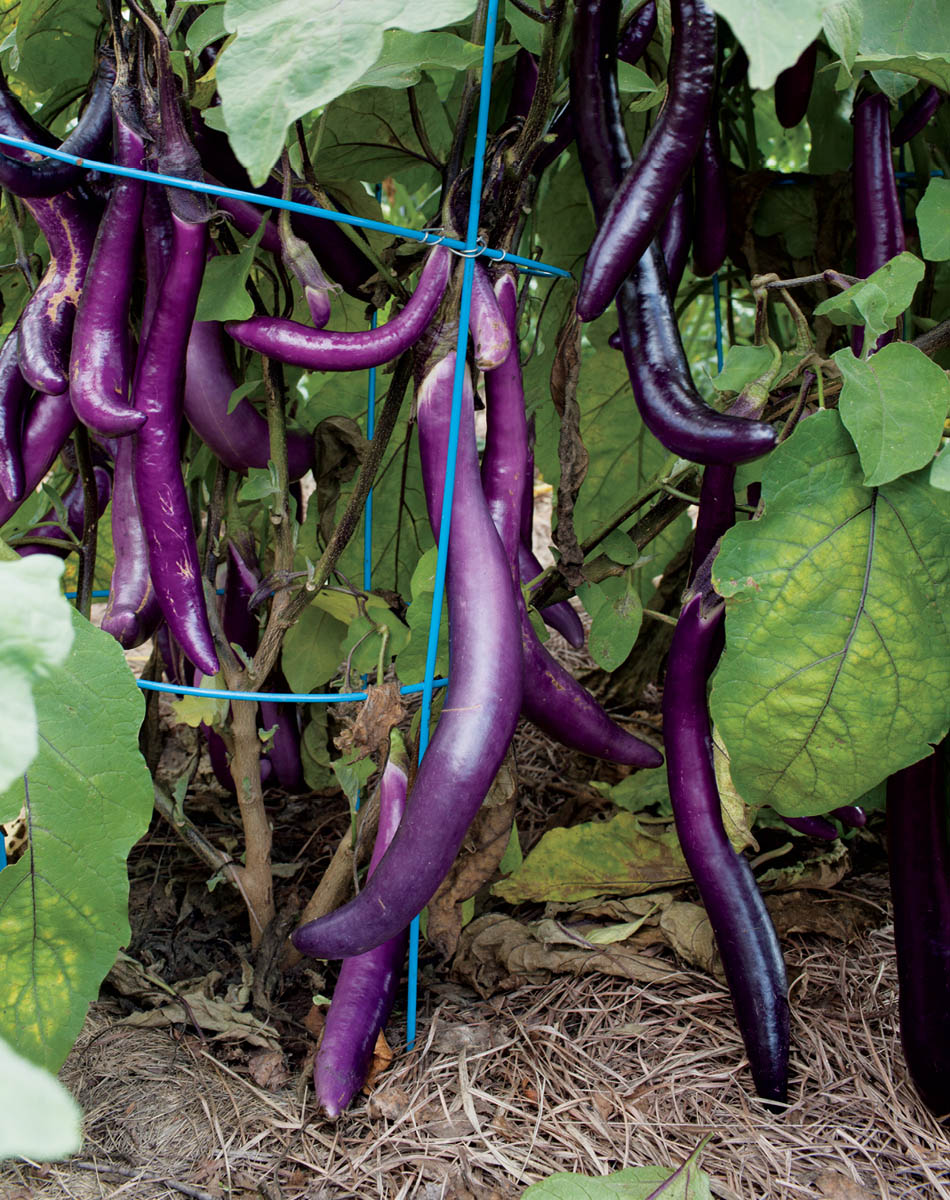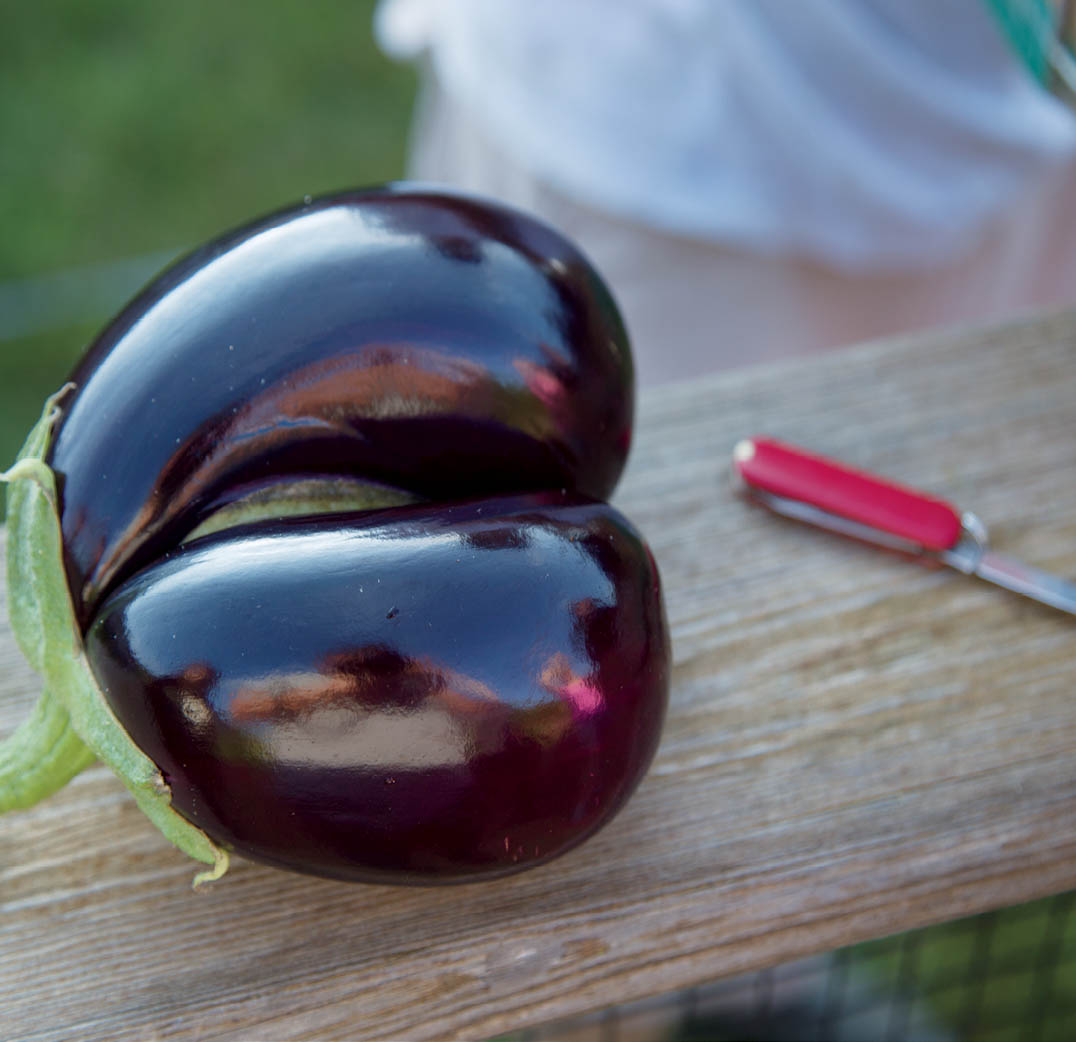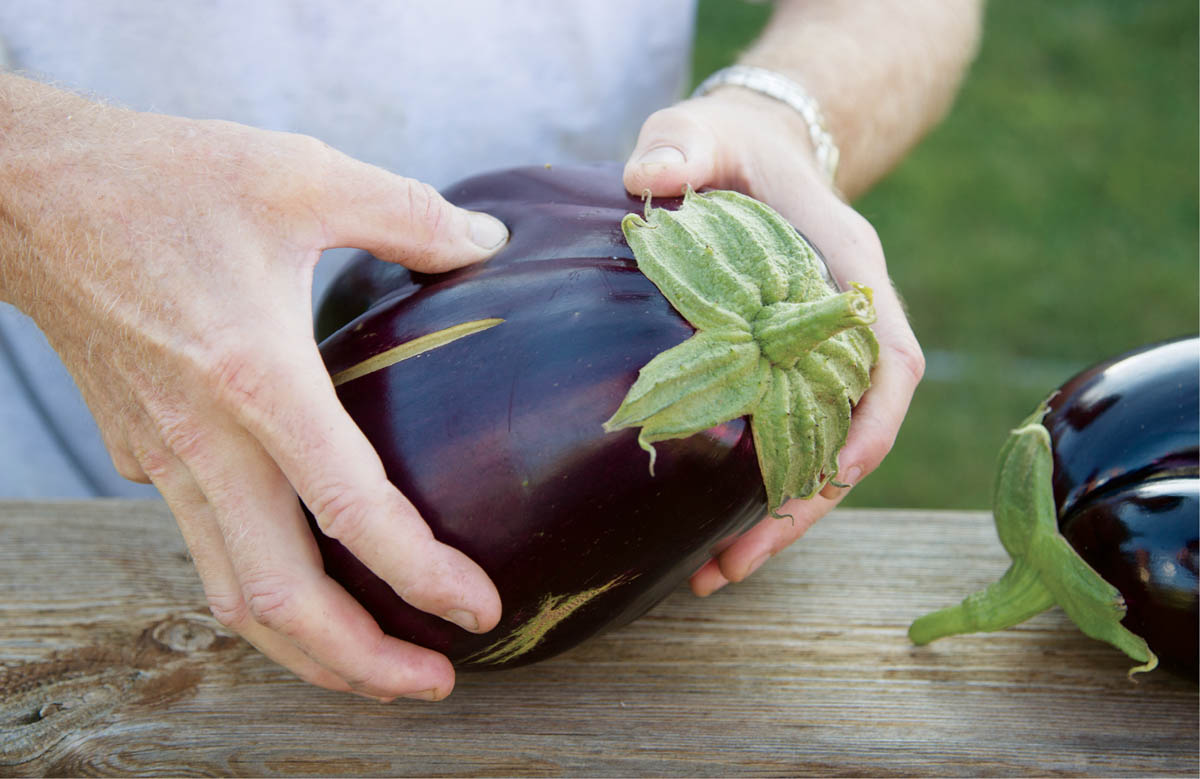
So many exceptional eggplants, so little time to grow them. Even if you’ve never planted an eggplant before, you owe it to yourself to give it a try. These ornamental plants are prized around the globe for their good-looking fruits, which hide a delectable interior. Spend some time studying the list of potential prizewinners, and then plant several kinds to see which of your aubergines take home the ribbons.

Eggplant is the most exotic of the mighty garden triumvirate that includes tomatoes and peppers. Meld these three ingredients together, and they make for some of the tastiest recipes on the planet. It’s been that way for ages.
Some food historians believe eggplants originated in northwest India, where they’ve been cultivated for thousands of years. Others think the place of origin is China, where the early records of its cultivation appeared in 59 BCE. The eggplant also traveled west to Europe, where other cultures adopted this vegetable as their own.
If you visit India, Turkey, Greece, China, Egypt, Japan, Bangladesh, Malaysia, Indonesia, Spain, Italy, France, or many other countries, you’ll find at least one national dish that features eggplant as the main ingredient. Notice any large North American country missing from the list? Eggplant is one of the least popular edibles in America. According to commercial eggplant producers, annual per-person consumption is about 1 pound of eggplant each year. In other countries, the per-person annual consumption can be over 100 pounds. Just let that eggplant fact marinate for a moment.
Because of its affiliation with its toxic cousins in the nightshade family (Solanaceae), eggplant wasn’t widely accepted when it was first introduced to Europeans centuries ago. The fruit eventually gained popularity first in France in the 1600s, and then in England. Thomas Jefferson supposedly introduced eggplant to American gardens, but it took many more years before people started enjoying eggplant as an edible fruit instead of an ornamental.
There are several species of edible eggplants. These including the gilo (Brazilian jiló) or scarlet eggplant (Solanum aethiopicum), the Gboma or African eggplant (Solanum macrocarpon), and the most common garden-grown eggplant (Solanum melongena).
If you don’t like eggplant, you might enjoy aubergine, brinjal, melanzana, or a plate of “little dark blue things.” How does that sound? The fruit that pops to mind when any American says “eggplant” has many different aliases around the world. Depending where on the globe you’re standing, you might hear our ordinary eggplant called all sorts of names: garden egg, eggfruit, guinea squash, pea apple, king of vegetables, or brown jolly. Eggplant has also been called mad apple and the apple of insanity for its close association with other members of the nightshade family.
It seems the name is as well traveled as the fruit itself. Language experts say they can trace the etymology of aubergine to Sanskrit, the ancient language linked to India. The British named it egg plant, because the fruits introduced early on were small, white, and shaped like a chicken or goose egg. They gradually adopted the word aubergine from the French, which was derived from alberginia from Catalan, borrowed from something related in Portuguese, which in turn came from al-bādhinjān in Arabic, which was lifted from a similar Persian word, attributed to vātin-gana- (or vātinjana-) found in Sanskrit.
The first aubergines exported from Europe to America were similar to the ornamental and edible variety ‘Easter Egg’. Gardeners can still grow these small egglike fruits for an exceptional eggplant entry at the county fair. Americans are probably most familiar with eggplants of the large purple oval form. But there’s a wide wonderful world of eggplants of every stripe such as long-fruited Asian types, teeny-tiny fruits, and others that look like an oversized drawstring purse. Every eggplant I’ve grown has offered nice velvety green foliage and lovely lavender flowers, and that’s before setting its fabulous fruit.
Whether glossy globe or slender and slightly curved, the eggplants we grow today all began as small bitter fruits that took years to be tamed into something sleek and edible. Generations of seed-saving and crossbreeding made it possible for us to enjoy fruits that range in size from small eggs to large spheres in a range of rich colors.


To prevent damage to the fruits, grow plants in a tomato cage to keep them upright and off the soil. If individual eggplants touch the soil, place a leaf or other barrier under them.
Most contests have several classes for eggplants: standard, Asian, and what I like to call “gardener’s choice.” Because there are usually only a few classes, spend some time reading through catalog descriptions. Maybe you’ll decide to enter an eggplant in each category. Challenge yourself to show an exotic specimen the judges and fairgoers might not have seen before, like ‘Applegreen’, ‘Turkish Italian Orange’, ‘Lao Purple Stripe’, ‘Thai Yellow Egg’, or the enormous and impressive ‘Rotonda Bianca Sfumata di Rosa’.
Whichever eggplants you choose, read the descriptions carefully. Match the number of days from transplanting to maturity to make sure you’ll have a good crop, at the perfect stage, when the vegetable contests are accepting entries.

Would it surprise you to learn eggplant is a perennial? The majority of North American gardeners grow eggplants as an annual because the climate isn’t subtropical. But the plant can be perennial where summer nights are hot and steamy and it doesn’t freeze in winter. Eggplants can be a bit temperamental to grow where conditions are less than ideal. They do best when they get what they want and can balk at any disruption to their environment. Cool weather, cold soil, hungry insects, dry spells, or anything that stresses the plant can hamper growth and production. However, if you’re a conscientious caretaker, your gardening efforts will be rewarded.
In cooler climates you can set up water-filled plant protectors, plastic tunnels, or row covers to coddle eggplants. For perfect show-worthy specimens in the United Kingdom, gardeners typically grow their aubergines in greenhouses, using the same cultural practices and fertilizers as for greenhouse tomatoes.
Growing eggplants is similar to growing peppers and tomatoes (their cousins in the nightshade family). To grow exceptional eggplants, avoid planting in the same spot where they were planted during the previous two to three seasons. Also avoid planting where tomatoes, peppers, or potatoes grew.
Eggplants are adaptable to small-space gardens and can be planted in raised beds, square-foot gardens, and patio containers. Miniatures like purple-and-white-striped ‘Fairy Tale’ grow on plants less than 3 feet tall. Other good choices for smaller spaces include dark purple eggplants like ‘Hansel’, ‘Patio Baby’, and ‘Ophelia’; white-skinned fruits like ‘Gretel’ or ‘Ivory’.
Eggplant wasn’t always included in horticultural contests, at least in the British Isles. It was left out of the extensive exhibition list of the 1892 “Horticultural Exhibitors’ Handbook” published in Scotland. One reason may be that eggplants were difficult to grow in cool climates, especially before the development of modern varieties. The bulletin “Exhibiting Fruit and Vegetables in British Columbia” (1913) explained that the “Egg-Plant” class was only in “the Dry Belt sections” of the province.
But culinary tastes may be the real reason. Edwin Beckett addressed the topic of eggplants (Solanum esculentum) in his 1899 gardening book Vegetables for Exhibition and Home Consumption in the United Kingdom. Winner of a gold medal for vegetables from the Royal Horticultural Society, he explained that eggplants had limited appeal as an edible among gardeners in the United Kingdom. In France and other “continental countries,” he said they are largely cultivated for culinary purposes, and “when properly served they form a most acceptable dish to those who have acquired a taste for their handsome fruits.” In England, eggplants were then usually cultivated for ornament only, and, as Beckett noted, “when grown and carrying a heavy crop of fruit, the plants present a highly attractive appearance.” Although it wasn’t fashionable to harvest the fruits, Beckett deigned to explain how gardeners and cottagers could present “egg plants” for the show bench, adding that “for exhibition, in a mixed collection of vegetables arranged for effect, these are very useful and always admired by the visitors.”
One way to grow better eggplants is to start with grafted plants. Commercial eggplant producers have used grafted eggplants since the 1960s to grow crops that are more tolerant of environmental stresses such as soilborne diseases, low temperatures, drought, and flooding. Growers who use grafted eggplants report fewer soilborne disease problems, improved yields (50 percent or more), and plants that bear higher-quality fruit over a longer period of time.
Using a standard grafting technique, producers graft one eggplant scion onto another eggplant’s rootstock. Growers typically use an eggplant that produces higher quality or better tasting fruit for the scion, grafting this onto a tougher, more disease-resistant rootstock. The rootstock typically is chosen for high resistance to soilborne diseases (Verticillium wilt and bacterial wilt), or soil-dwelling parasites like root-knot nematodes. Grafted eggplants can also thrive in less-than-ideal soil conditions.
You can now grow grafted eggplants, too. Investing in grafted eggplants could be helpful in small-space gardens that have soil problems or limited space for rotating crops every year. The important thing to remember when planting grafted eggplants is to make sure the graft union is above the soil line. This prevents the union from rooting in the soil, which would negate the benefits of using a grafted rootstock.
Here are some favorites gardeners recommend taking to the show:

Eggplants are usually grown from transplants. They may take a long season, sometimes more than 80 days from transplanting until the first harvest. To time your seed-sowing, consider your region’s last average day for spring frost, but also allow time for nighttime temperatures to warm considerably before planting. Eggplants like hot weather, but during exceptionally hot days the flowers may not set fruit. Where summers are hot, time planting carefully so fruit will set before temperatures heat up in your garden.
Start seeds indoors 8 to 10 weeks before transplanting outdoors. Baby them with bottom heat to help with germination. After they show a few leaves, transplant into individual pots and place them under grow lights to keep them warm.
Another option is to wait until frost is a distant memory and purchase healthy transplants from a garden center known for providing high-quality care to their plants. With eggplants, problems that start early can last all season.
Acclimate plants adequately before planting outdoors to reduce transplant shock and to give roots a good start. Wait for warm soil (above 60°F) and warm nights (55°F) before planting because cold roots and cool nights will slow their early growth. Cold weather can also cause misshapen or poor quality fruit.
Researchers who study eggplant production say it’s better to transplant into larger containers if necessary, than to plant them in the garden while the soil temperatures are still cool. If you’re in a hurry to get planting, use black plastic mulch to warm the soil. When soil and plants are ready, cut holes in the plastic and plant.
Choose a spot in full sun, in fertile, well-drained soil for your transplants. Give eggplants plenty of room to grow by spacing them 18 to 24 inches apart, with 3 feet between rows. Try not to disturb plant roots once they’re in the ground.
Think optimistically and plan ahead. Add a tomato cage or other support to prevent branches from breaking under heavy fruit loads. Supports are especially helpful to keep fruit off the ground and for growing straighter Asian eggplant varieties. The cage also makes it easy to quickly cover the plants during an unexpected cold snap, or to protect the plants from damaging winds.

Double-fruited eggplants won’t win in regular competition, but you can enter them in the novelty category.

Simply entering a less common variety, such as ‘White Star’, can increase your odds of taking home a ribbon.
Eggplants grow best with consistent deep watering. Where rainfall is scant, you’ll need to supply several gallons of water for each plant, each week. Drip irrigation is a good method for keeping foliage dry while maintaining soil moisture when fruits are forming and growing.
Uneven soil moisture can show up as blossom-end rot or poorly formed fruit. If leaves yellow, show spots, and start to drop, it could signal a water deficit; too much water will show up as flowers that drop without setting fruit. Blossoms may also drop during extreme temperature fluctuations.
Eggplants need a constant supply of nutrients during their growing season. Feed with a balanced liquid fertilizer when plants have set a few fruits. Plants may need an additional boost of fertilizer every few weeks during the season to promote growth and fruit production.
Add thick layers of organic mulch to help maintain soil moisture and reduce the need for cultivation. If weeds appear, hand pull or use shallow cultivation to avoid damaging plant roots.


To test an eggplant for maturity, gently press the skin with the pad of your thumb. If the indentation springs back to normal, it’s ripe. If the indentation remains in the skin, it’s not ready for the fair.
To grow a good crop of eggplants, you’ll need to get buzzing. Bees are the primary pollinators of eggplant flowers, and bumblebees do most of the heavy lifting. Buzz pollination happens when a bumblebee lands on a flower and gives it a big hug to force out the pollen. To create this kind of activity, you’ll want to attract as many bumblebees as you can to your garden. Here’s how to provide what bees need:
A common mistake for beginning growers is waiting to harvest the eggplants until they’re as large as those found in grocery stores. If fruit is left too long, the production of fruit will slow or stop, and the fruit that remains on the plant will lose its sheen and become seedy.
Keep track of the average days to harvest for each eggplant, and start checking fruit around the estimated maturity date. Another indicator is size; watch to see when eggplants reach their estimated mature size.
Even if you’re still well in advance of the contest, start harvesting and eating as soon as eggplants are ready. Picking will result in a higher yield overall. Use pruners to carefully clip fruit from the stem to avoid damage. Eggplants bruise easily, so handle with care by putting the emphasis on egg. Fruit quality can decline quickly; refrigerate for one or two days at the most. Commercial eggplant producers hold eggplants at a temperature of 45 to 50°F and 90 to 95 percent relative humidity.
Eggplants are susceptible to the same insect pests and disease problems of related tomatoes, peppers, and potatoes. You can avoid most problems with good cultural practices. Keep the garden clear of plant debris and weeds, make sure there’s good drainage, plant healthy transplants, and maintain good soil fertility. Rotating crops helps prevent soilborne diseases and also reduces depletion of soil nutrients. Aim for growing big plants with good leaf cover to protect fruit from sunscald (a plant’s version of sunburn, which shows up as pale spots on fruits). In addition to the problems described under tomatoes and peppers, here are a few that may crop up:
Colorado potato beetles are yellow-and-black–striped pests that harm potato crops and are also damaging to eggplant, peppers, and tomatoes. These beetles are eggplant enemies because they devour leaves and ruin entire crops. Check plants daily for the pests and handpick.
Spider mite infestations can show up as small specks on leaves before the leaves turn yellow and drop. Spider mites can cause a plant to quit producing. Check the underside of leaves for the small red mites, and use high-pressure water from the hose to knock them off.
Flea beetles can make leaves look like they’ve been hit with buckshot, so they must be stopped before they can get started. Exclude flea beetles by covering plants with row cover cloth sealed at the edges, or cover individual plants until flowering begins.
Cutworms like tender eggplant transplants and can take down a young transplant overnight. Keep them away by placing collars around the stems at planting time.
Verticillium wilt is a soilborne disease that starts in the roots and can result in little or no fruit. If plant leaves suddenly wilt and turn brown, this may be the culprit. You can prevent problems with wilt diseases by rotating crops, but avoiding rotations among tomatoes, peppers, potatoes, and eggplant.
If there’s any doubt eggplant is Jere Gettle’s favorite crop, just take a look through The Baker Creek Vegan Cookbook. Its recipes from the Gettle family kitchen include Heirloom Roasted Eggplant Pizza, Baba Ghanoush, Breaded Heirloom Eggplant Cutlets, Russian Eggplant-and-Shiitake Pockets, and Ping Tung Eggplant Cake.

Gettle, the founder and owner of Baker Creek Heirloom Seeds in Mansfield, Missouri, loves the eggplant for its culinary uses. “I love to eat it because there’s a lot of variation in the flavor, depending on the variety.” He eats a lot, too: “I eat 100 to 150 pounds of eggplant a year,” he says. “In the summer I eat it maybe two or three times a day, in some form or another.”
Jere also likes to collect eggplants. Every year he plants more than 70 different varieties, and he appreciates every single plant. “They’re easy to grow and they have beautiful flowers and foliage, too.”
He credits his expanded vision of eggplant to a trip to Thailand in 2002. That’s when he had the chance to see what an important food crop it is to people in other places of the world. It was exciting to walk through open-air marketplaces, filled with vendors and shoppers in their native dress, and see more than 20 different varieties of eggplant for sale. In places like Thailand — and India, Indonesia, Korea, and Japan — eggplant is served raw in salad bars, steamed, baked, pickled, jellied, blended into chutneys, and made into candies and sweet cakes.
While eggplant hunting, Jere searches for the most interesting varieties to bring home and share with other gardeners. Once he finds a unique variety, like ‘Thai Lavender Frog Egg’, he’ll look for a ripe eggplant hidden somewhere in the pile. “That can be difficult, because most of the fruit is sold in the immature stage, when it tastes the best,” he explains. “But usually I can find a couple of overripe ones to buy and then scrape out the seeds.”
If the seeds germinate, they’ll be planted in the company’s Missouri trial gardens. Then, if the plants and fruit meet Baker Creek’s exacting standards, the eggplant could be featured in the seed catalog. That might happen right away, or it might take years. It all depends on what other projects (and eggplants) Jere has on his plate.
One of his many favorites is ‘Malaysian Dark Red’. This variety appeals to him because of its dark reddish skin, which is matte with a parchment-like finish, instead of shiny. The eggplant grows to about 10 inches long and tastes “tremendous.”
‘Rosita’, from Puerto Rico, is another of Jere’s top choices. The fruit of this plant is bright neon purple with pink undertones, and its flavor is especially appealing to those who prefer bitter-free fruit.
Jere says the most popular eggplant in the Baker Creek catalog is ‘Aswad’, the seeds of which were sent to him from a friend in Iraq. The fruits are big and blocky and grow to weigh 3 pounds or more.
For success in eggplant growing, Jere recommends giving plants a medium-rich soil, just like that for tomatoes and peppers. It’s especially important to remember eggplant originated in a climate with warm nights. “It’s better to wait and put them out the first of June instead of the first of May,” he says. “They’ll grow just as fast or faster, and they’ll make (form) really quick.”
Another tip is to treat plants for flea beetles as soon as they’re transplanted. Jere recommends spreading diatomaceous earth on the leaves of plants to repel the harmful pests. Sprinkle the powder on the foliage after a rain, and re-treat plants several times a week until the flea beetle invasion is over.
Jere says it would be difficult for him to judge eggplant entries at a vegetable contest, because he’d be most interested in only one thing: flavor. “There’s so much to consider,” he adds. He’s never satisfied, because “there are always new eggplants to try, something new on the horizon.” He also says if he had to choose only one crop to grow, it would probably be eggplant. “It always takes up more room in the garden than it should.”
Look for fruits that are medium to large and firm, with a uniform, deep color and glossy sheen. To make sure eggplants are ready to exhibit, apply the thumbprint test. Lightly press your thumb into the eggplant. If the pressure leaves a dent, the eggplant is not ripe and shouldn’t be harvested. If the thumbprint springs back it’s ready to be picked.
Harvest eggplant as close to the competition as possible, so the “cap” or calyx is fresh and green, with no brown edges. Use hand pruners, scissors, or a knife to cut fruit from the plant. Cut into a sample fruit to make sure seeds are still soft; hard seeds mean an eggplant is overmature. Exhibiting younger fruit at the fair is better than showing specimens that are past their prime. Handle carefully to prevent bruising or dulling the skin with oily fingerprints.



